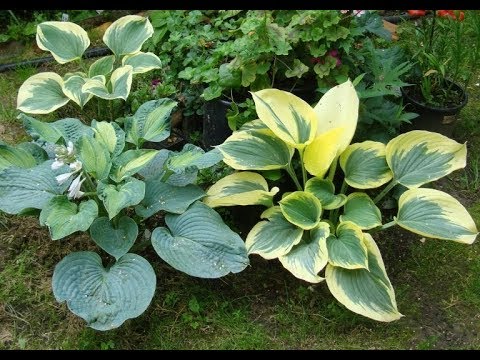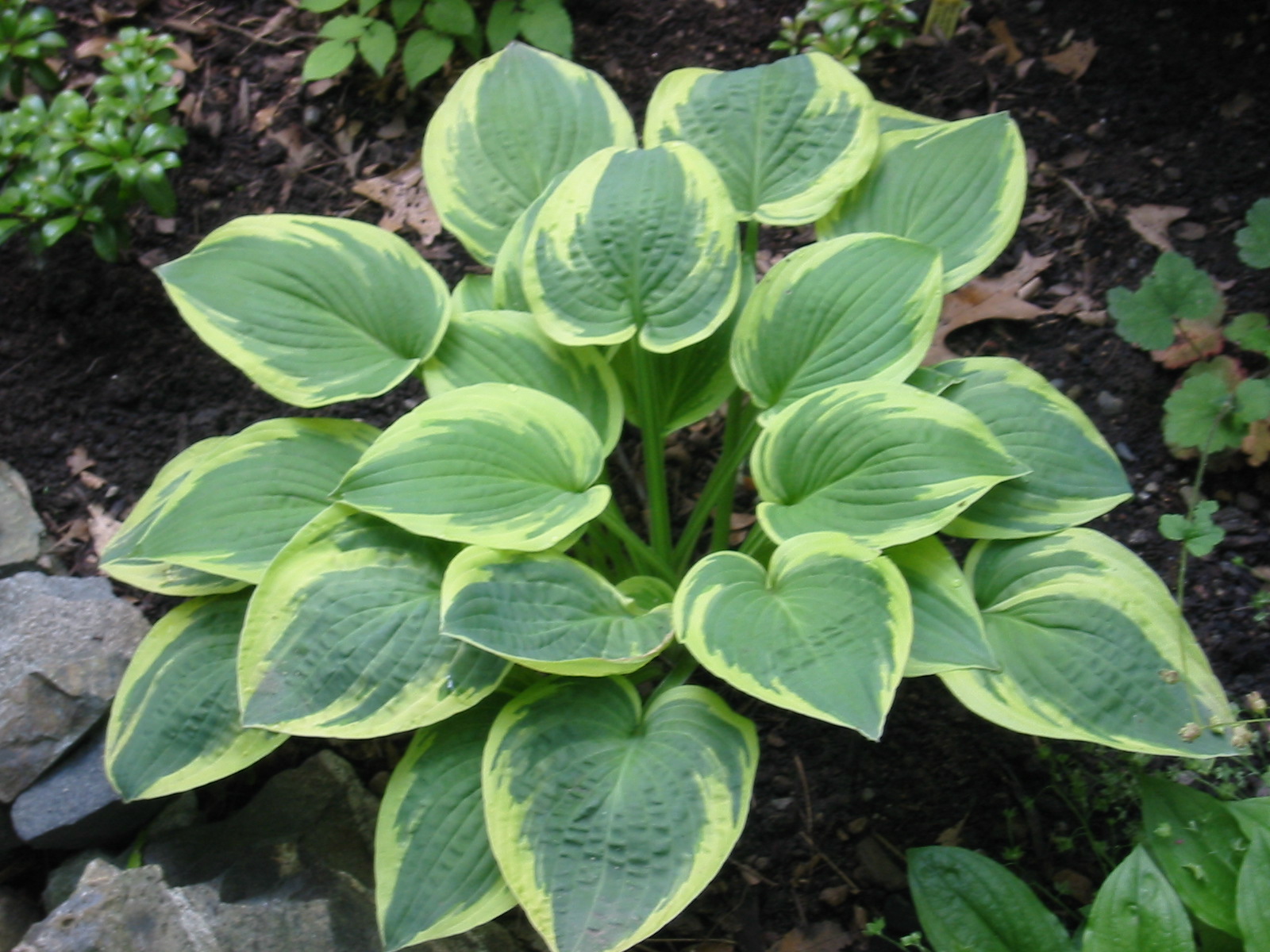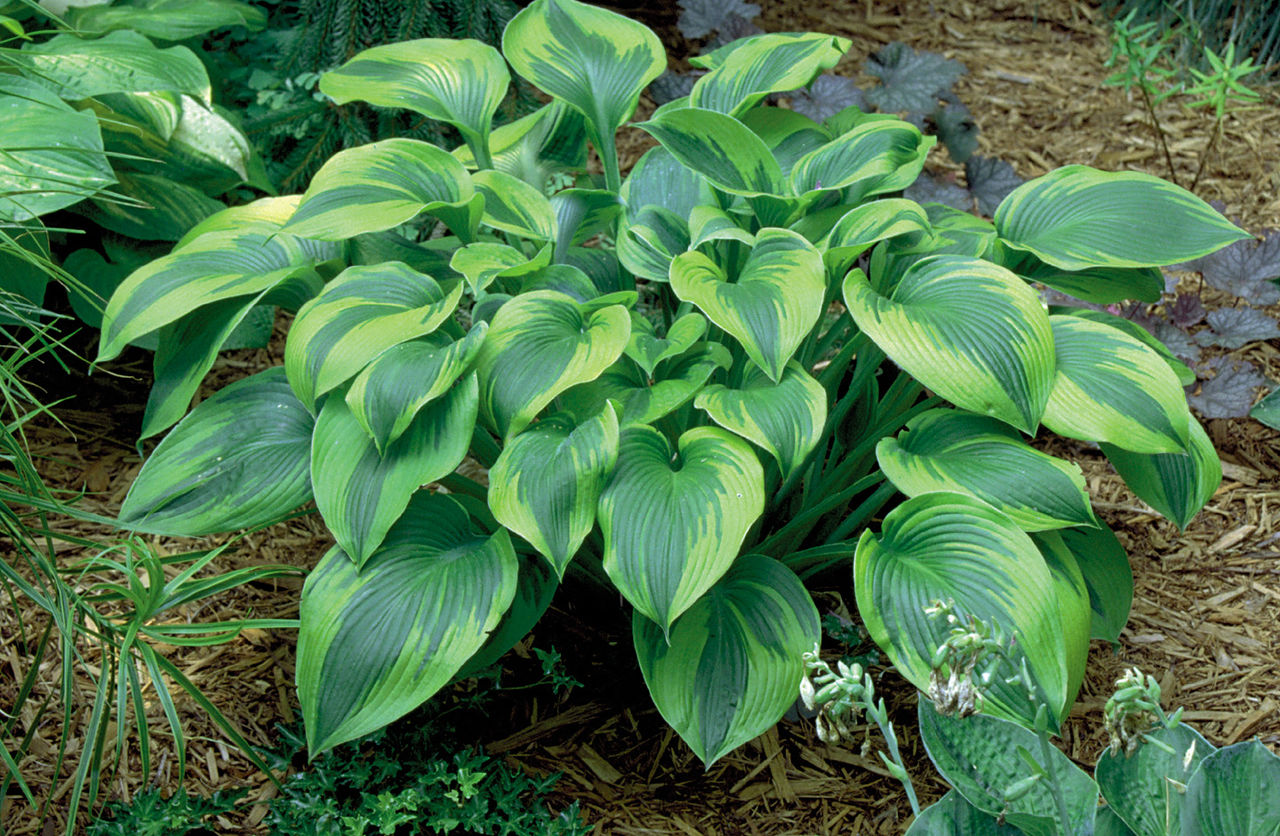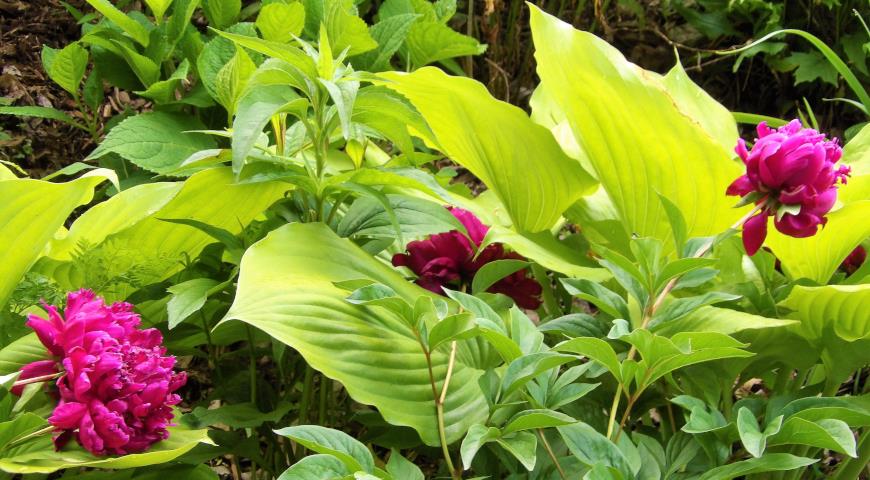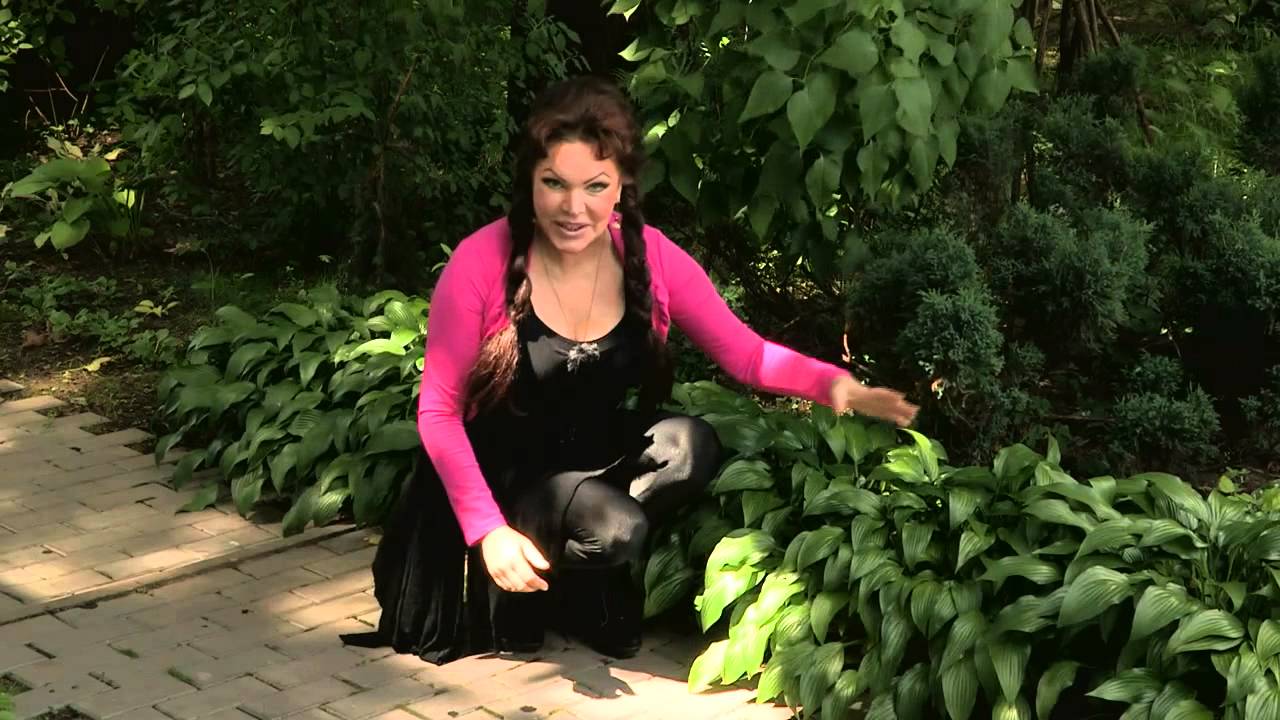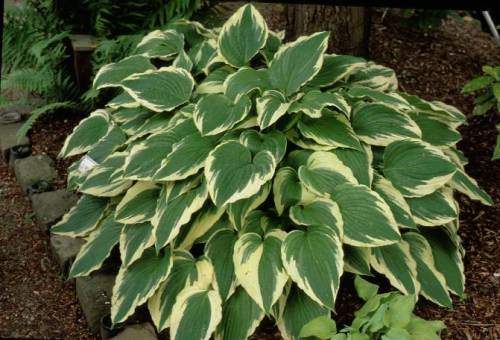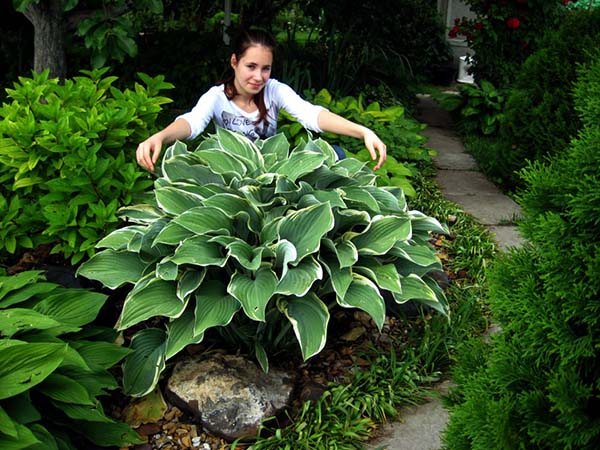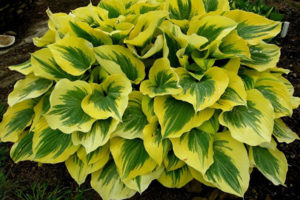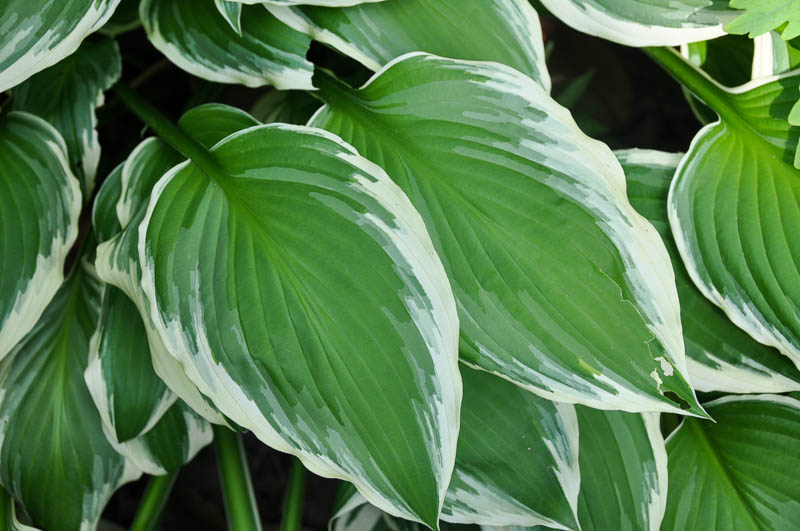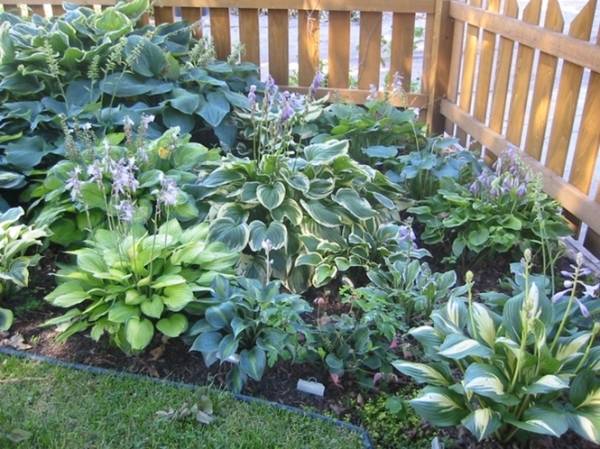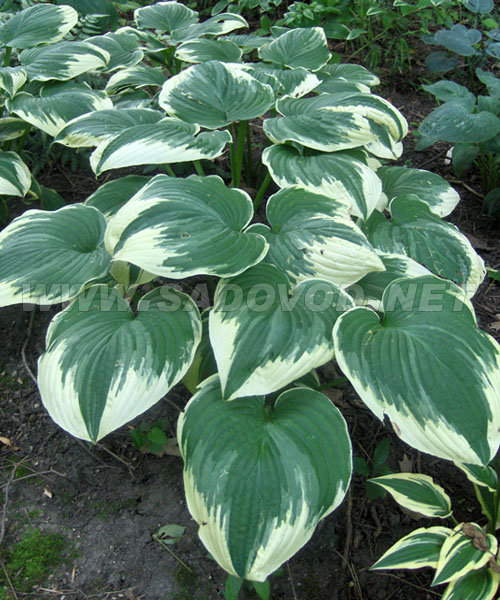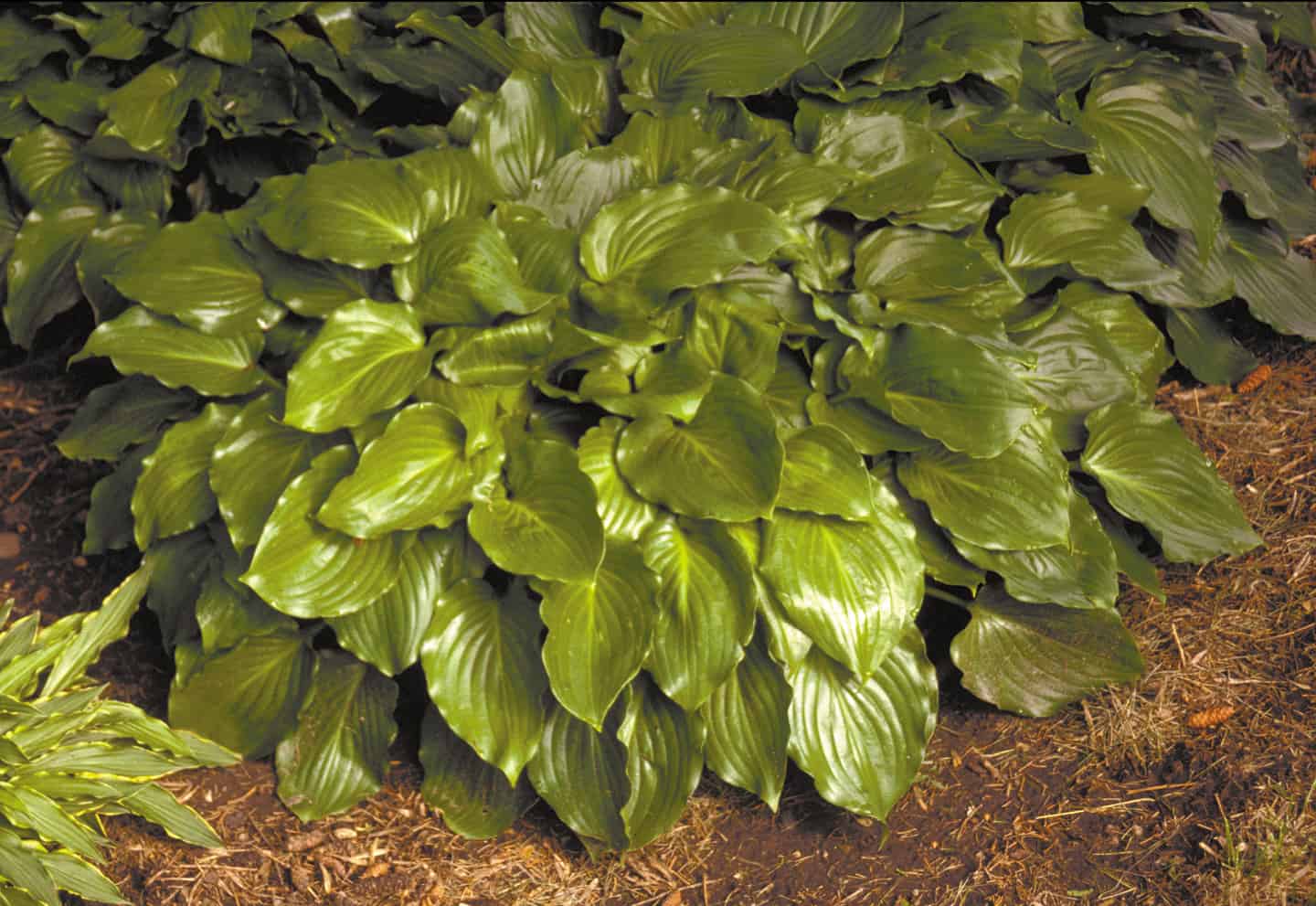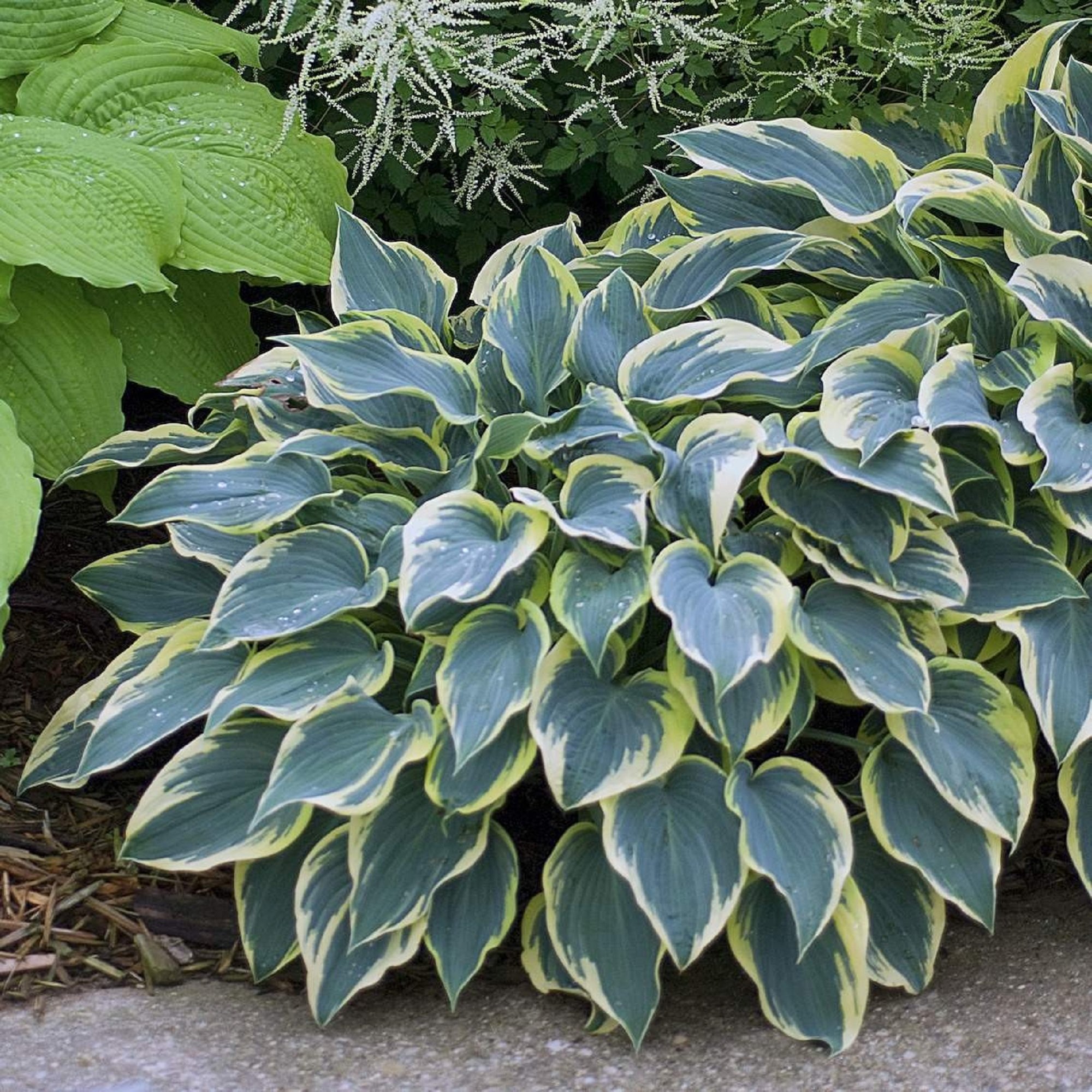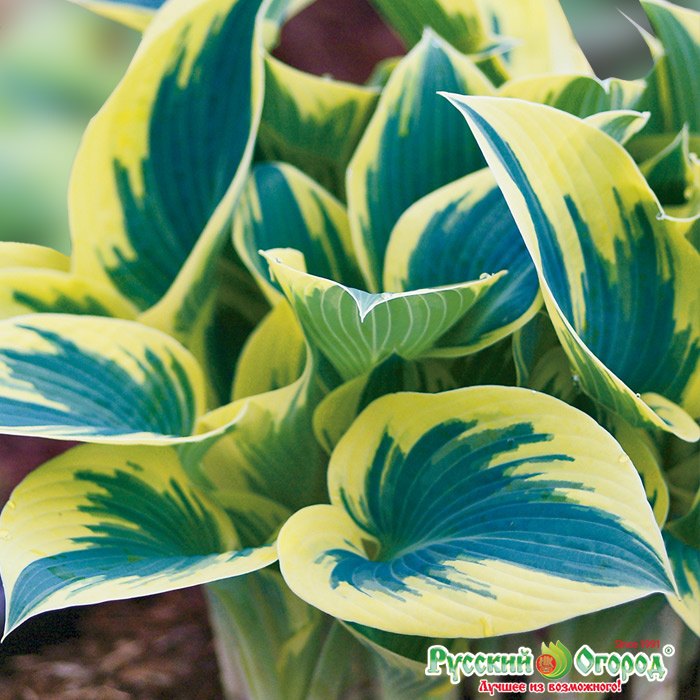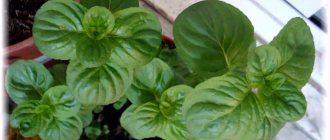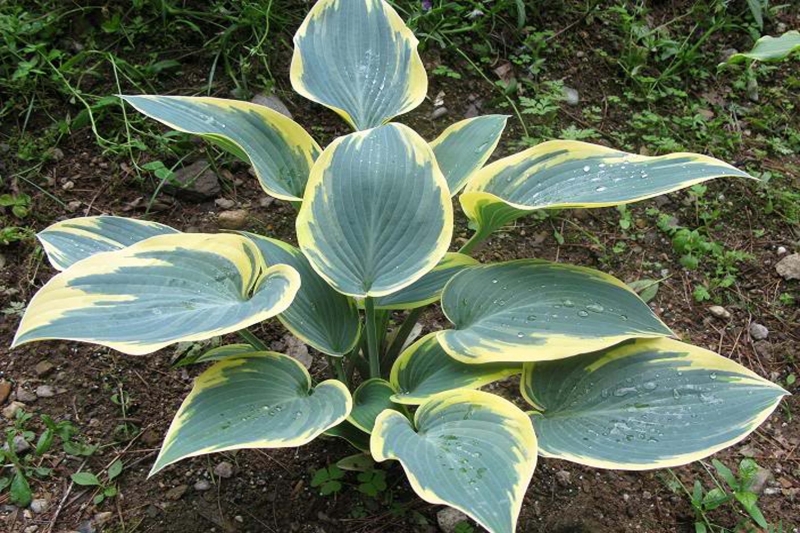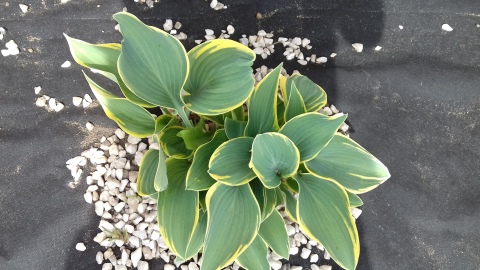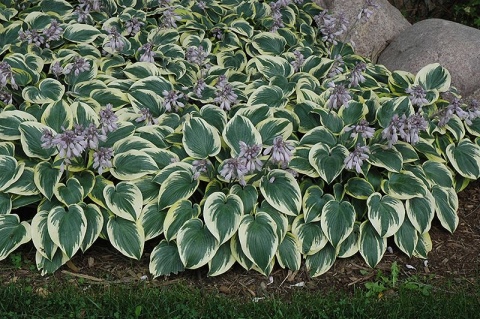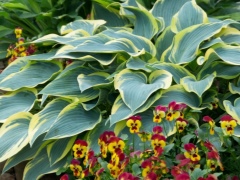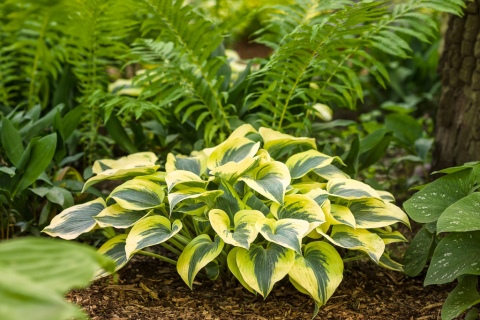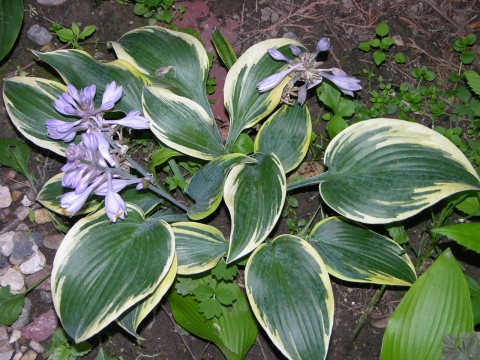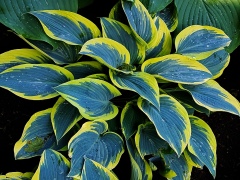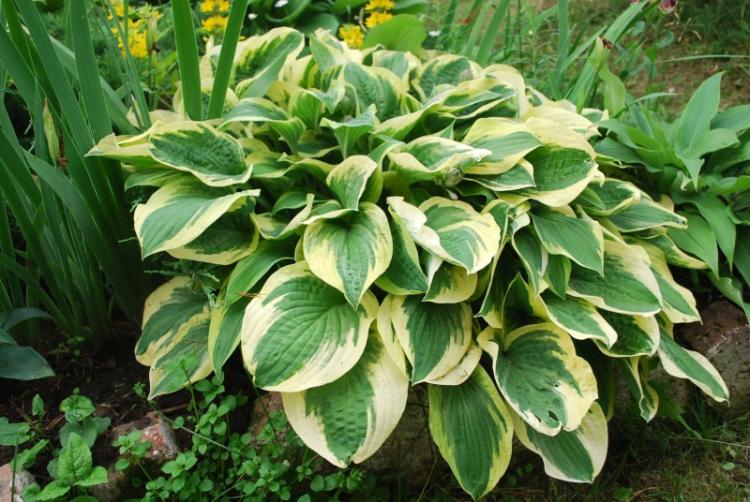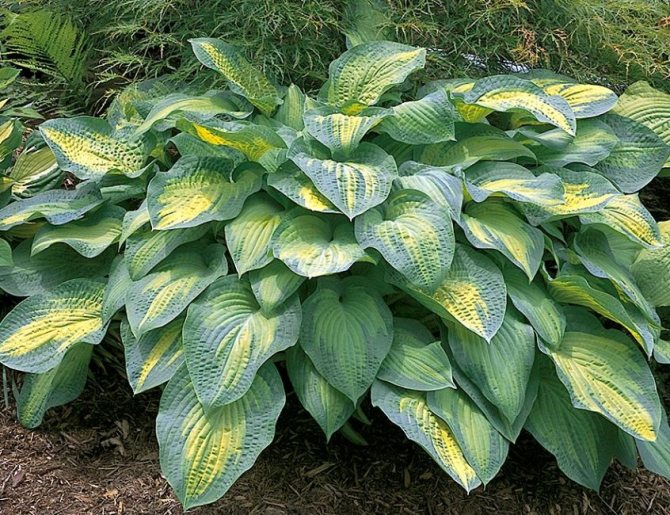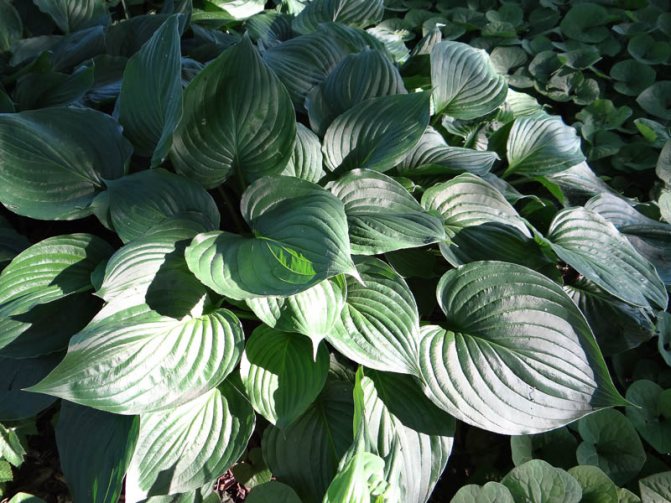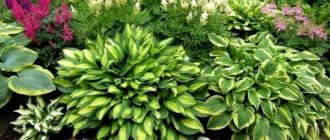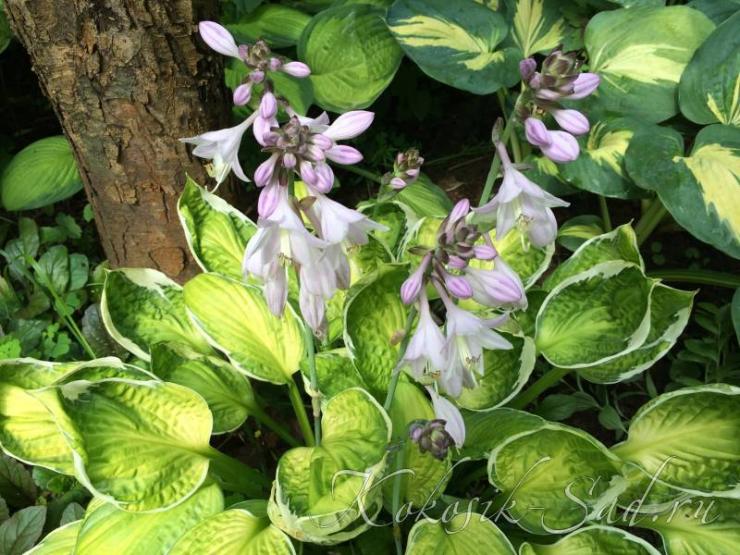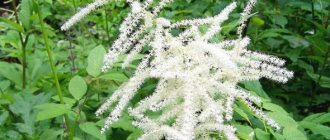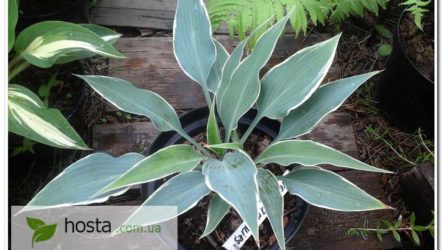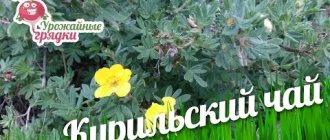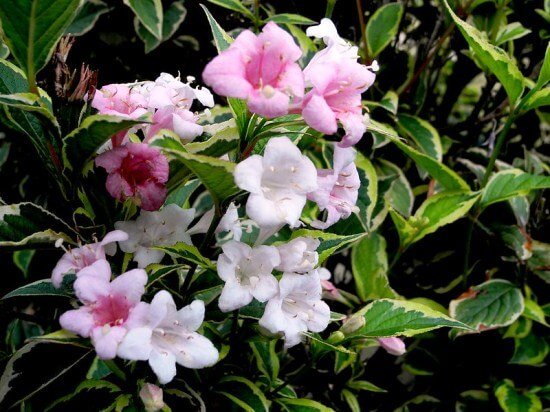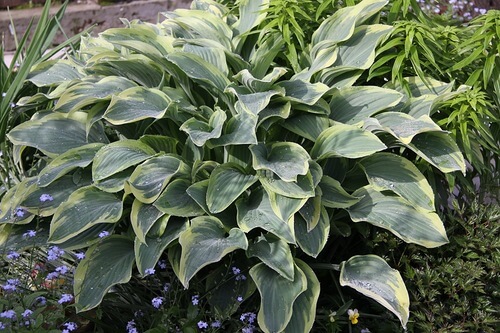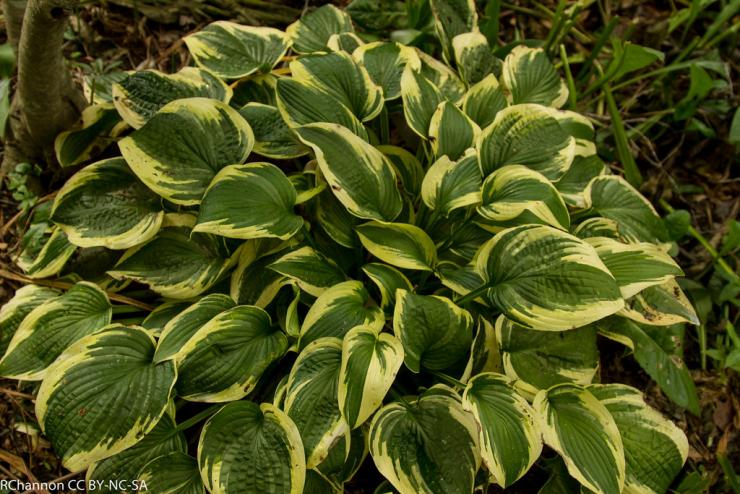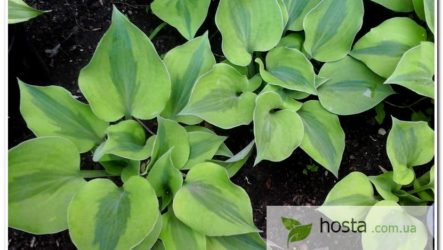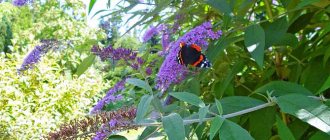Description
Hosta First Frost is a perennial herbaceous hybrid plant that belongs to the lily family. The natural habitat of this flower is the territory of the Far East, East Asia and Japan. This variety has been enjoying well-deserved popularity among gardeners from around the world for many years.
This flower is medium in size and has a beautiful milky border on all leaf blades. In early spring, the border has a more yellow color, but in summer its shade becomes tender milk. The height of an adult plant does not exceed 40 cm, and the diameter of the bush is 80 cm.
Due to the presence of hard and coarse leaf plates, the plant is practically not damaged by pests. The flower has an unusual shade of leaves - blue. The average leaf length is 20 cm, and the width is 10 cm. The leaf plates are located on petioles, which form a large basal rosette.
The maximum height of the peduncle is 100 cm. The flowering period of the plant is mid-summer. The flowers are bell-shaped and form brushes-like inflorescences.
| Variety hosts First Frost | |
|---|---|
| Bush hosts First Frost | |
| The size: | Average. (M). |
| Bush height, cm: | 25 |
| Bush width, cm: | 76 |
| Bush shape: | Fountain-shaped |
| Lighting conditions: | In the morning - sunny, then light to moderate shade. |
| First Frost hosts list | |
| Color in the center of the leaf: | Blue |
| Leaf border color: | Yellow → White. |
| Variation: | Along the edge of the sheet |
| Color change: | Bluescent. The blue color turns green by autumn. |
| Leaf shape: | Elliptical |
| Sheet length, cm: | 18 |
| Sheet width, cm: | 12 |
| Leaf texture: | Dense |
| Blooming hosts First Frost | |
| Peduncle height, cm: | 45 |
| Colour: | Pale lavender |
| Drawing on a flower: | No |
| Flower smell: | No |
| Flowering time: | July |
| Seeds: | does not tie |
| The history of the appearance of hosts First Frost | |
| Registration year: | 2002 |
| Place of registration: | USA, North Carolina |
| Originator: | Patricia Scolnik, Bob Solberg 2002 |
| Origin: | Sports by hosta Halcyon |
First Frost host can also be found under the names: First Frost.
Possible translation: First Frost.
- Host of 2010 according to (American Hosta Growers Association, USA).
- According to the survey results, First Frost hosts were included in the hosta rating according to the American Host Society. (See Ranking host varieties by score).
Description of hosts Fest Frost
It is a compact deciduous plant. The height of the bush is up to 40 cm, and the width is 60-70 cm. At the same time, the length of the leaves can reach 14-16 cm. It grows best in partial shade, in the sun the color of the bush fades.
The leaves are very dense, dark green in color with a yellow border on the sides. In the spring "Fest Frost" is brighter. Due to the color, it seems that the sheets are covered with frost, which is why the name of the described variety came about.
Hosts "Fest Frost" are medium spreading. They do not need a garter or support to shape. The neat appearance remains until late autumn, until foliage begins to fall from the bush.
The plant has a beautiful edging on the leaves, in early spring the border has a yellow color, in the summer it is soft milk
Hosts are not demanding on the composition and nutritional value of the soil. In one place, he can be up to 20 years. In the future, a transplant is required.
Flowering occurs in late July - early August. During this period, the bush is covered with light lavender flowers.
This is another important decorative property of the Fest Frost Hosta. Flowering lasts an average of 3 weeks
The plant tolerates low temperatures well. Therefore, it is popular with flower growers from regions with different climatic conditions. Also, the Fest Frost variety is resistant to diseases and pests.
Application in landscape design
Hosts look good in flower beds and flower beds in combination with other ornamental plants. They are often used for framing or zoning plots, as well as for decorating artificial ponds, benches and other summer cottages.
Usually hosts are used to add pomp. Therefore, they are planted in places where there are few bright colors. The host is suitable for multi-tiered flower beds and decorative compositions. Fest Frost goes well with other varieties.
Among them:
- Francis Williams.
- August.
- Golden Meadows.
- Wide brim.
- Whirlwind.
The flower can become both an independent green planting and part of a beautiful composition.
Shade-loving hosts also pair well with lavenders, peonies, lilies, daylilies and gladioli. Representatives of the Fest Frost variety feel comfortable next to phlox, lungwort and irises. Together, these plants can beautify any home garden.
Landscaping applications and compatibility with other plants
The hosta loves shade, so garden flowers that love the same growing conditions will grow most favorably nearby. It goes well with rose bushes, lilies, junipers. They feel good in the neighborhood of fern, astilba, dicenter, rhododendron. It looks especially impressive in the meadow in combination with the Heuchera plant, Rogersia and Horny Goat weed.
In landscape design, next to the flowers of the host should be planted - forget-me-nots, they perfectly emphasize the blue varieties. Against the background of large leaves, the Icelandic poppy will look advantageous. If thuja or other conifers grow in your garden, the hosta will become a favorable neighbor. Hiding in the shade of a thuja, the bush will be provided with comfortable conditions.
Elegans
Elegance can rightfully be considered one of the most delicious host varieties. The bush is striking in its size: its height is on average 65 cm, and even more during flowering due to flowers on high stems. The bush of an adult plant grows up to 130 cm wide!
The elegans hosts are especially proud of the large heart-shaped leaves of a jade shade, the length of which can reach 37 cm. But these hosts are no less attractive during flowering. At the end of summer, beautiful snow-white flowers, shaped like tubular lilies, bloom on tall peduncles.
If you love beautiful plants and do not want to spend a lot of time caring for them, plant in your flower garden not only hosts, but also other unpretentious perennials for the garden.
| Leaf color | Height (cm) | Bush diameter (cm) | Distance between plants (cm) |
| Gray with light green border | 30-60 | 60-100 | 100 |
| Leaf color | Height (cm) | Bush diameter (cm) | Distance between plants (cm) |
| Light green in the center, gray at the edges | 35-40 | 70 | 75-90 |
| Leaf color | Height (cm) | Bush diameter (cm) | Distance between plants (cm) |
| Green, light yellow around the edges | 35-40 | 60-75 | 60-90 |
| Leaf color | Height (cm) | Bush diameter (cm) | Distance between plants (cm) |
| Green | 60-90 | 90-110 | 120 |
| Leaf color | Height (cm) | Bush diameter (cm) | Distance between plants (cm) |
| Gray with a yellow border around the edges | 40 | 60-70 | 60-90 |
| Leaf color | Height (cm) | Bush diameter (cm) | Distance between plants (cm) |
| Gray with a yellow-green border around the edges | 80 | 90-130 | 120 |
| Leaf color | Height (cm) | Bush diameter (cm) | Distance between plants (cm) |
| Jade | 65-90 | 90-130 | 90-120 |
Examples in landscape design
Hosta "First frost" is a very beautiful and unusual plant, which is widely used for decorating not only personal plots, but also city flower beds and alleys. This flower can become both an independent green planting and a part of a beautiful composition.
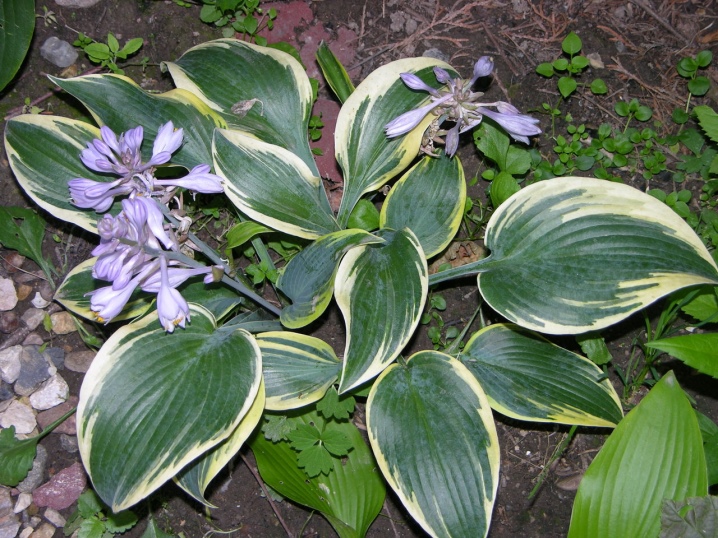
Green architecture experts recommend planting a variegated hosta against a background of monochromatic plants, the color of which will effectively emphasize the beauty of the flower. Joint planting of hosts with all types of cereals looks no less advantageous.
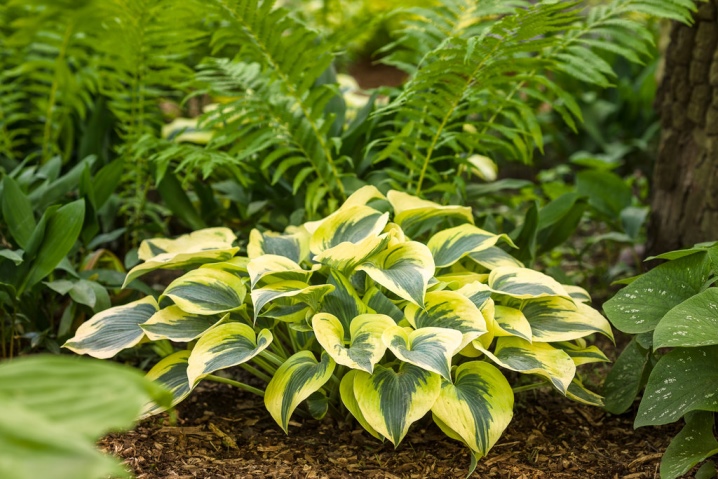
Many designers use this flower as a curb plant that looks very impressive near garden paths. For the aesthetic decoration of nondescript fences, experts recommend planting alternately variegated and monochromatic hosts along their entire length.This plant looks harmoniously with all astilbe, daylilies and bruners.
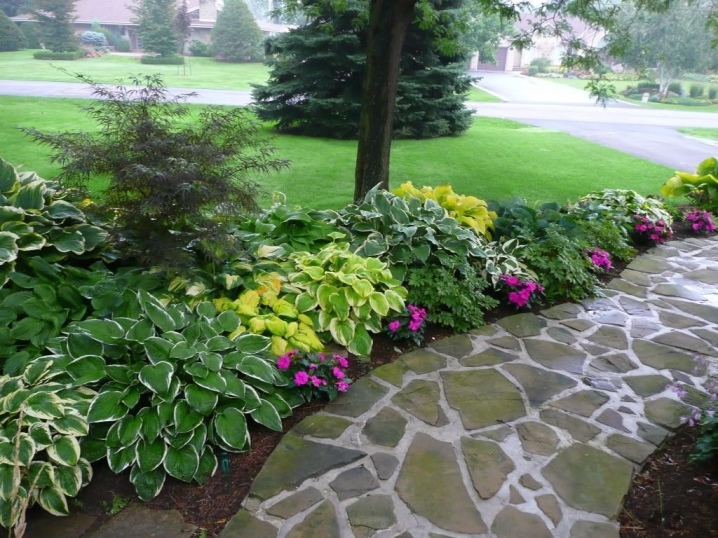
For the tricks of growing hosts on the site, see below.
Care
The function needs regular watering, moderate feeding and pre-winter pruning. A few simple maintenance measures are required for good growth and excellent decorative effect.

Hosta first frost photo
Watering
For good growth of the funkii, moderately moist soil is needed, so it should be watered 2-3 times a week (in the absence of rainfall).
1-2 buckets of water are consumed per bush, depending on the size. Watering is desirable in the morning, trying not to wet the leaves.
Top dressing
You need to feed the funkia in spring and autumn, mulching the bush with compost or other organic fertilizers. After laying the mulch, the bush is well watered.
Additionally, you can carry out top dressing before flowering using water-soluble mineral complexes.
Pruning and preparing for winter
Dry peduncles are cut after flowering so that they do not spoil the decorative shape of the bush. When the leaves turn yellow and lie on the ground, they carry out pre-winter pruning - they cut off the entire ground part.
Types and varieties of plants for growing in garden glades
The leaves, depending on the variety, can be green, blue and yellow. There are veins on the leaves. Also, the plant may differ in the shape of the leaves and their relief. This culture will decorate any landscape and is suitable for creating mono-flower beds. Against the background of the variety of varieties, the most popular are:
- Plantain
- First Frost
- Captains Adventure
- Blue Ivory
- Liberty
- Pandoras Box
Plantain variety
Hosta Podorozhnikovaya
It is considered the most common crop. The leaves are green, with a relief surface. Reaches 60 cm in height. Bushes grow well. The roots stick out from the soil, because of this, they do not tolerate winter well. So that the plant does not freeze out, timely planting of the bushes is required. May change shade during the season.
First Frost (First Frost)
Hosta First Frost
Spectacular in appearance, fast growing, perennial crop. This variety always looks smart. The color of the leaves, depending on the season, varies from blue to green in the center with a yellow border. The flowers are delicate lavender. Blooms in the second half of summer. The variety is shade-tolerant, unpretentious to soil and care.
Captains Adventure
Hosta Captains Adventure
Tricolor, medium size. The shape of the leaves is elongated, with pointed tips. Height 40-45 cm. Leaves are yellow-green. Blooms from July to August with small bells. Loves partial shade, moisture and mulched soil.
Blue Ivory (Blue Ivory)
Hosta Blue Ivory
The plant is bluish-blue in color with a white edging on the leaves. Bushes of this variety are of medium growth rate. It blooms with light blue inflorescences, starting in July. The height of the bush reaches 45 cm. An unpretentious culture will not burden you with unnecessary care. Will be a worthy decoration for shaded areas of the garden. Possesses high winter hardiness.
Liberty (Liberty)
Hosta Liberty
Awarded with prestigious awards, the hosta variety has a very beautiful coloration. Leaves are green-yellow, pointed in shape. It is considered a giant, the height reaches 90-100 cm. The perennial grows slowly, blooms in mid-summer with small lavender inflorescences. The plant creates shade well, fits into the background of flower beds.
Pandoras boxing (Pandora's Box)
Hosta Pandora's Box
Dwarf variety. The leaves are round-heart-shaped. The color is gray-green with white blotches. The height of an adult bush is up to 10 cm. Suitable for growing in flower beds and pots. The bush looks interesting in the shade. The root system is slowly developing. The bushes are frost-resistant.
Landing features
When choosing a shrub for planting in your garden, you should know that the Wide Brim host grows well in both lighted and shaded areas.
You can plant the plant next to fruit trees that can protect the host from the sun's rays with their shade. Hosta Wide Brim loves loose, drained soils with an acidified composition. In order for the shrub to develop well, the earth in the trunk circle should not dry out. An increased amount of moisture is necessary for the plant during the formation of inflorescences. In addition, the size of the leaves depends on the moisture content. The darkening of their tips can serve as a signal for urgent watering.

Landing rules provide for:
- placement of 3-5 bushes per 1 m 2;
- before planting, it is necessary to carefully dig up the earth, remove weeds, acidify the soil, if it is neutral;
- the soil must be enriched with fertile garden or leafy soil;
- the planting of hosta seedlings - grown seedlings - is carried out at the beginning of September;
- between the pits, corresponding to the size of the roots, maintain a distance of 50 cm;
- after laying the drainage layer, mineral fertilizers and organic matter are added.
Hosta Robert Frost: description, photo, landing and care
Hosta Robert Frost - Leaves are rounded, dark blue-green, dense, slightly wrinkled, with a wide irregularly shaped yellow-cream border that turns almost white at the end of the season. Some light strokes extend to the very middle of the sheet. White flowers on high peduncles
Host Description Robert Frost. Large, fast growing host. Bush up to 70 cm high. Bush width up to 90 cm... Peduncles 90 cm. Flowering period July. Winter hardiness zone: 3 (-40 ° С)
Hosta, or funkiya, is a perennial herb of the Liliaceae family. The hosts are home to China and Japan. It is an ornamental deciduous perennial. Hosta leaves are about 20 cm long, up to 10 cm wide, located on petioles and form a large basal rosette. They can have various shapes and colors, be monochromatic or with edging, with or without a wax coating, with a straight or wavy edge. The flowering stems are glabrous, from 20 to 100 cm high. The flowers are bell-shaped or funnel-shaped, blue, lilac or white, collected in racemose inflorescences. Hosta blooms in July-August.
Landing site for Host Robert Frost. Hosts can grow in both shade and sun, but most of them prefer slightly shaded areas. Variegated species are more light-loving. Plants need protection from drafts and strong winds. The soil for the host is suitable for fertile, moist enough, but without stagnant water.
Landing Host Robert Frost. Before landing, the hosts dig up a plot of 1 sq.m. add a bucket of humus and a complete mineral fertilizer. Small holes are dug at a distance of 30-50 cm from each other, corresponding to the size of the root system. Drainage is laid at the bottom, garden soil is poured, rhizomes are placed, spreading the roots, and covered with garden soil on top. The soil is compacted, well watered, planting is mulched.
Host Robert Frost care. The hosts do not need special care. Plants must be watered in a timely manner, weed out, fed with organic matter or mineral fertilizers. An excellent technique is the surface mulching of the soil with humus, it allows you to retain moisture and creates favorable soil conditions for the plant. In autumn, the hosts are not pruned, only the peduncles are removed. They also do not need shelter for the winter, the culture tolerates frosts down to -40 ° C.
Reproduction of Host Robert Frost. Propagated by host separation of the bush and cuttings. Adult shrubs are divided in early spring (before early May) or autumn (in September). To do this, the plant is abundantly watered, dug up and divided into several parts, so that each of them has 1-2 leaf sockets. The resulting cuttings are immediately planted in a permanent place. Hosta cuttings can be carried out throughout the summer. To do this, young shoots with a heel are separated from the plant, the leaves are cut by a third, planted in a shady place, covered with a plastic bottle. In the first days, the leaves will lie on the ground - the turgor is lost, but after a couple of weeks the cuttings will take root.
Using Host Robert Frost in garden design.Hosta is great for landing along the shore of a reservoir, for rocky gardens, mixborders, planting along paths. It looks impressively planted in groups against the background of an emerald lawn. Ornamental hosta leaves are widely used to create bouquets.

